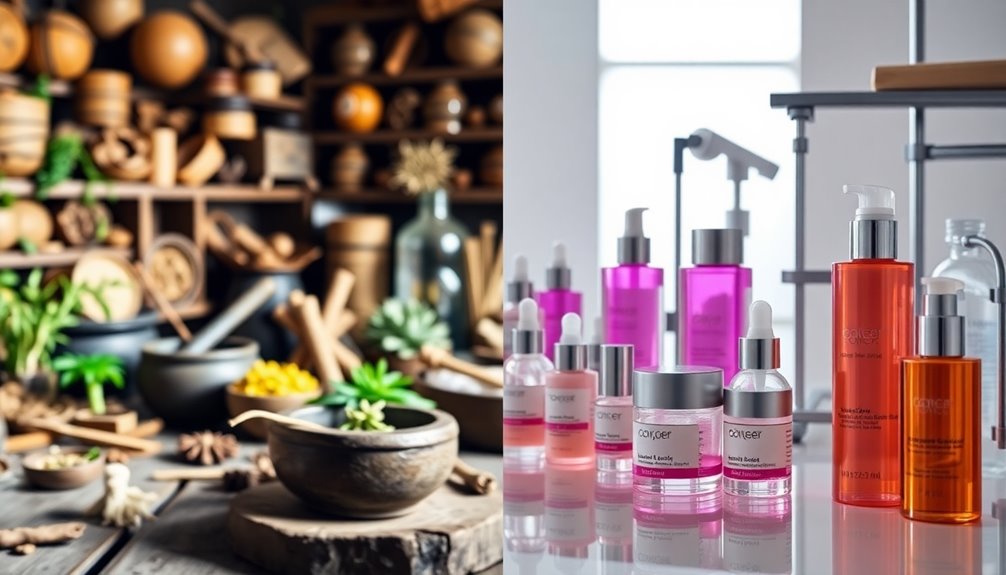Discover the remarkable evolution of collagen, starting from ancient civilizations using natural substances for facial enhancement to the thriving modern beauty industry where collagen remains a staple. The journey of collagen traces back to ancient times when plant-based ingredients were used to promote skin health and natural beauty. In the 1970s, collagen-based fillers emerged as a breakthrough, offering a safe and natural solution for facial rejuvenation. With advancements in technology, collagen treatments have been revolutionized, showcasing enhanced stability, longevity, and safety. Learn more about the fascinating transformation of collagen from ancient remedies to modern beauty must-have.
Key Takeaways
- Collagen dates back to ancient civilizations for facial enhancement.
- Synthetic fillers in the 19th century led to collagen's breakthrough in the 1970s.
- Collagen fillers offer natural results with minimal risk and temporary effects.
- Hyaluronic acid surpassed collagen in the late 1990s for longer-lasting hydration.
- Recent technology advancements improved collagen stability, precision, and safety.
Ancient Origins
Dating back to ancient civilizations, the origins of collagen evolution trace back to a time when natural substances like honey, beeswax, and plant oils were utilized for facial enhancement and wrinkle reduction. In ancient times, people valued natural beauty and sought ways to maintain skin health using plant-based ingredients.
Historical records reveal that early cosmetic practices focused on facial rejuvenation, aiming to reduce wrinkles and enhance overall skin appearance. The use of plant-based fillers to address facial lines and skin aging concerns was prevalent across various cultures, reflecting a desire for youthful and healthy skin.
Through these ancient remedies, individuals sought to improve skin health, reduce signs of aging, and achieve a natural glow. The roots of collagen evolution can be traced back to these early experiments with natural ingredients, highlighting a timeless pursuit of beauty and skin well-being.
Early Experiments
During the late 19th and early 20th centuries, a wave of experimentation emerged in the field of facial enhancement, leading to the exploration of synthetic fillers like paraffin wax, silicone, and liquid mercury. These early experiments aimed to address skin imperfections by introducing foreign substances into the skin to enhance its appearance. However, the risks associated with these synthetic fillers were significant, with adverse reactions such as infection, migration, and allergic reactions commonly reported.
Physicians and scientists were pioneers in testing new substances for facial fillers during this experimental period. Despite their efforts, the use of synthetic fillers posed challenges, as complications were frequent and sometimes severe. This era of trial and error eventually paved the way for the introduction of collagen-based fillers in the 1970s, marking a significant breakthrough in facial enhancement procedures.
Collagen, a structural protein essential for skin elasticity and firmness, offered a more natural solution with minimal risk compared to the early synthetic fillers.
Collagen Revolution
With the emergence of the collagen revolution in the 1970s, a significant breakthrough in facial enhancement procedures was achieved. Collagen-based fillers, sourced from bovine or human origins, revolutionized beauty treatments by providing natural-looking results with minimal risk. Despite their temporary effects lasting a few months, these fillers were instrumental in adding volume and improving skin texture.
The collagen revolution not only set the stage for collagen's widespread use in modern beauty treatments but also paved the way for advancements in filler technology. Over the years, innovations such as cross-linking technology and advanced delivery systems have enhanced the stability, longevity, precision, and safety of collagen-based fillers. This evolution in filler technology has allowed individuals to enjoy the benefits of collagen fillers with increased effectiveness and reduced risks, contributing to the ongoing popularity of collagen in the beauty industry.
Rise of Hyaluronic Acid
Amidst the ever-evolving landscape of cosmetic enhancements, a standout player emerged in the late 1990s – hyaluronic acid. This remarkable compound, naturally found in the body, revolutionized cosmetic procedures with its skin hydration properties and safety compared to collagen fillers.
Hyaluronic acid fillers offer longer-lasting results, lasting from 6 months to 2 years, depending on the type used. Recent advancements in filler technology, such as cross-linking for stability and innovative delivery systems like cannulas, have further enhanced the efficacy and safety of hyaluronic acid treatments.
Advancements in Technology
The era of cosmetic enhancements witnessed a noteworthy shift with the rise of hyaluronic acid in the late 1990s, offering a safer and more effective alternative to collagen fillers. Recent advancements in filler technology have revolutionized collagen treatments. By cross-linking high protein molecules, stability and longevity of fillers have remarkably improved, ensuring long-lasting effects for patients.
Innovative delivery systems, such as cannulas, have enhanced precision and safety in administering collagen supplements, promoting skin regeneration with minimal risk. Chemically modifying hyaluronic acid molecules has resulted in more stable fillers that provide safe and effective results over an extended period. These advanced filler technologies have reduced the risk of filler degradation, leading to enhanced outcomes and increased patient satisfaction.
The evolution of technology in collagen treatments continues to push boundaries, offering individuals seeking skin rejuvenation a blend of science and beauty for optimal results.
Frequently Asked Questions
What Is the History of Collagen?
You've wondered about the history of collagen. It's been used for centuries in traditional medicine. Ancient cultures valued its skin benefits. Synthetic fillers were tried in the past, but the 1970s collagen revolution brought safer, natural-looking results.
Are Collagen Peptides Legit?
Yes, collagen peptides are legit. They are scientifically proven to enhance skin elasticity, hydration, and reduce wrinkles. Plus, they can boost nail and hair quality, support joint health, maintain muscle mass, and aid gut integrity.
Which Collagen Powder Does Jennifer Aniston Use?
Jennifer Aniston uses Essential Proteins Collagen Peptides in her daily routine for skin health and beauty. The high-quality, easily absorbed collagen powder helps maintain skin elasticity and reduce signs of aging. It's a popular choice for natural skincare solutions.
What Are the Side Effects of Ancient Collagen?
Ancient collagen remedies, like plant-based fillers, had risks, such as infection and migration. Back then, side effects could include skin irritation, allergic reactions, and even disfigurement. It's important to take into account these factors when exploring historical beauty practices.
Conclusion
So, there you have it – from ancient remedies to modern beauty staple, collagen has truly evolved over the years. With advancements in technology and the rise of ingredients like hyaluronic acid, collagen products continue to revolutionize the beauty industry. So next time you reach for that collagen-infused serum or mask, remember the long journey this powerful ingredient has taken to become a skincare essential.


